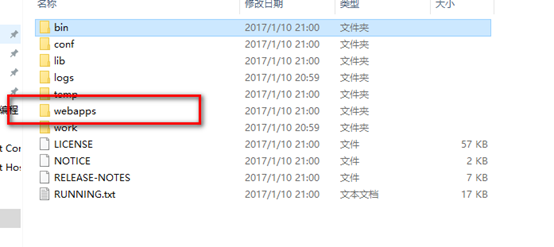tomcat阅读第十篇(tomcat組件之Host)
使用过tomcat的都知道,我们的Host是会配置在Engine标签下面的在Server.xml中,所以这篇我们将要看的是另一个Container----------Host,下面是Host的继承关系图。

看Host源码可以看到,大部分都是get/set方法,之前分析我们知道,这个是跟Server.xml的元素属性相配合的,现在主要看set方法。
public interface Host extends Container { // addAlias Event public static final String ADD_ALIAS_EVENT = "addAlias"; // removeAlias Event public static final String REMOVE_ALIAS_EVENT = "removeAlias"; // ------------------------------------------------------------- Properties ……. //设置这个Host的root Xml,如果为空默认是${catalina.base}/conf/Enginename/Hostname/ public void setXmlBase(String xmlBase); //返回这个Host的默认的配置文件 public File getConfigBaseFile(); //返回这个Host的application root public String getAppBase(); //返回这个Host的application root file public File getAppBaseFile(); //设置个Host 的application root public void setAppBase(String appBase); //设置是否自动发布 public void setAutoDeploy(boolean autoDeploy); //设置Context Configuration Class public void setConfigClass(String configClass); //设置那个host的webapps是否自动发现和发布 public void setDeployOnStartup(boolean deployOnStartup); //设置appBase的正则表达式,如果会自动发布,这个将被忽略 public void setDeployIgnore(String deployIgnore); //启动和停止Context的Executor public ExecutorService getStartStopExecutor(); //如果true,则会为Host创建appBase和xmlBase的目录 public void setCreateDirs(boolean createDirs); //? public void setUndeployOldVersions(boolean undeployOldVersions); //Alias相关的方法 public void addAlias(String alias); public String[] findAliases(); public void removeAlias(String alias);
跟之前一样我们从Catalina的createStartDigester开始来看init过后StandardHost的对象链以及Server.xml中关于Host的配置。看createStartDigester源码我们知道跟Host相关的ruleset是HostRuleSet。
digester.addRuleSet(new HostRuleSet("Server/Service/Engine/"));
现在看HostRuleSet 类 addRuleInstances 方法:
public void addRuleInstances(Digester digester) { //解析到…Engine\Host的时候创建对象,如果指定了className则使用className指定的类创建,如果没有则默认使用org.apache.catalina.core.StandardHost digester.addObjectCreate(prefix + "Host", "org.apache.catalina.core.StandardHost", "className"); //设置Host标签属性给之前创建的Host对象 digester.addSetProperties(prefix + "Host"); // CopyParentClassLoaderRule 设置parent的classloader给child,这里的parent就是Engine,这里的child就是Host digester.addRule(prefix + "Host", new CopyParentClassLoaderRule()); // LifecycleListenerRule,看Host标签是否配置hostConfigClass属性,配置了就是使用创建LifecycleListener,如果没有设置,看parent也就是StandardEngine是否有这个属性,有则使用,最后都没有才会使用默认的org.apache.catalina.startup.HostConfig来创建,调用addLifecycleListener添加Listener digester.addRule(prefix + "Host", new LifecycleListenerRule ("org.apache.catalina.startup.HostConfig", "hostConfigClass")); //调用StandardEngine的addChild方法,传入StandardHost digester.addSetNext(prefix + "Host", "addChild", "org.apache.catalina.Container"); //解析到Host/Alias标签,调用StandardHost的addAlias方法,参数是Alias标签的content digester.addCallMethod(prefix + "Host/Alias", "addAlias", 0); //Cluster configuration start //跟Engine一样,配置Cluster,不赘述,以后会详细分析Cluster digester.addObjectCreate(prefix + "Host/Cluster", null, // MUST be specified in the element "className"); digester.addSetProperties(prefix + "Host/Cluster"); digester.addSetNext(prefix + "Host/Cluster", "setCluster", "org.apache.catalina.Cluster"); //Cluster configuration end //创建Host相关的Listener如果配置的话 digester.addObjectCreate(prefix + "Host/Listener", null, // MUST be specified in the element "className"); digester.addSetProperties(prefix + "Host/Listener"); digester.addSetNext(prefix + "Host/Listener", "addLifecycleListener", "org.apache.catalina.LifecycleListener"); //设置Realm,不赘述,后面会详细分析 digester.addRuleSet(new RealmRuleSet(prefix + "Host/")); //设置Host的valve,这个会在处理请求的时候起作用,关于请求后面会详细分析 digester.addObjectCreate(prefix + "Host/Valve", null, // MUST be specified in the element "className"); digester.addSetProperties(prefix + "Host/Valve"); digester.addSetNext(prefix + "Host/Valve", "addValve", "org.apache.catalina.Valve"); }
下面是Server.xml里面相对应的关于Host的配置

可以看出Host里面的几个属性,跟源码里面StandardHost的属性是匹配的,想熟悉配置,看源码是个最好的办法。
现在来看下StandardHost,看下它的构造函数
public StandardHost() { super(); pipeline.setBasic(new StandardHostValve()); }
有相对应的StandardHostValve,这个会在处理请求的时候起作用,Container的组件都会有这个,tomcat的组件不涉及到请求的复杂部分还是很整齐划一的。
看源码可以发现几个跟使用tomcat的时候相熟悉的属性
private String appBase = "webapps"; private volatile File appBaseFile = null; /** * The XML root for this Host. */ private String xmlBase = null; /** * host's default config path */ private volatile File hostConfigBase = null; /** * The auto deploy flag for this Host. */ private boolean autoDeploy = true; /** * The Java class name of the default context configuration class * for deployed web applications. */ //这是个重要的解析,负责解析Context private String configClass = "org.apache.catalina.startup.ContextConfig"; /** * The Java class name of the default Context implementation class for * deployed web applications. */ private String contextClass = "org.apache.catalina.core.StandardContext"; /** * The deploy on startup flag for this Host. */ private boolean deployOnStartup = true; /** * deploy Context XML config files property. */ private boolean deployXML = !Globals.IS_SECURITY_ENABLED; /** * Should XML files be copied to * $CATALINA_BASE/conf/<engine>/<host> by default when * a web application is deployed? */ private boolean copyXML = false; /** * The Java class name of the default error reporter implementation class * for deployed web applications. */ private String errorReportValveClass = "org.apache.catalina.valves.ErrorReportValve"; /** * Unpack WARs property. */ private boolean unpackWARs = true; /** * Work Directory base for applications. */ private String workDir = null; /** * Should we create directories upon startup for appBase and xmlBase */ private boolean createDirs = true;
因为ContainerBase上篇我们已经分析过了,现在看下StandardHost的XXXInternal方法,看源码发现只有StartInternal。
protected synchronized void startInternal() throws LifecycleException { //给Host的pipleline添加一个Valve,默认是org.apache.catalina.valves.ErrorReportValve String errorValve = getErrorReportValveClass(); if ((errorValve != null) && (!errorValve.equals(""))) { try { boolean found = false; Valve[] valves = getPipeline().getValves(); for (Valve valve : valves) { if (errorValve.equals(valve.getClass().getName())) { found = true; break; } } if(!found) { Valve valve = (Valve) Class.forName(errorValve).newInstance(); getPipeline().addValve(valve); } } catch (Throwable t) { ExceptionUtils.handleThrowable(t); log.error(sm.getString( "standardHost.invalidErrorReportValveClass", errorValve), t); } } super.startInternal(); }
除了XXXInternal方法,我们还要关注几个跟配置有关的方法getAppBaseFile、getConfigBaseFile
public File getAppBaseFile() { if (appBaseFile != null) { return appBaseFile; } //appBase默认是webapps,我们也可以直接设置 File file = new File(getAppBase()); //如果不是绝对路径,我们就要将我们的和CatalinaBase(默认就是启动tomcat的时候进去的dir的parent dir)拼接,前面分析可知,这个路径就是bootstrap.jar所在的文件夹的路径,然后加上默认的webapps,可以看下图 if (!file.isAbsolute()) { file = new File(getCatalinaBase(), file.getPath()); } // Make it canonical if possible try { file = file.getCanonicalFile(); } catch (IOException ioe) { // Ignore } this.appBaseFile = file; return file; }

public File getConfigBaseFile() { if (hostConfigBase != null) { return hostConfigBase; } String path = null; if (getXmlBase()!=null) { path = getXmlBase(); } else { //开始拼接Confg StringBuilder xmlDir = new StringBuilder("conf"); Container parent = getParent(); if (parent instanceof Engine) { //Config/Engine的名字 xmlDir.append('/'); xmlDir.append(parent.getName()); } xmlDir.append('/'); //Config/这个Houst所在的Engine的名字/这个Host的名字 xmlDir.append(getName()); path = xmlDir.toString(); } File file = new File(path); if (!file.isAbsolute()) //不是绝对路径,就加上CatalinaBase file = new File(getCatalinaBase(), path); try { file = file.getCanonicalFile(); } catch (IOException e) {// ignore } this.hostConfigBase = file; return file; }
现在来看下上面Digester解析提到的HostConfig,它是个LifeCyecleListner,所以我们主要关注,lifecycleEvent 方法
public void lifecycleEvent(LifecycleEvent event) { try { // StandardHost的配置设置到HostConfig host = (Host) event.getLifecycle(); if (host instanceof StandardHost) { setCopyXML(((StandardHost) host).isCopyXML()); setDeployXML(((StandardHost) host).isDeployXML()); setUnpackWARs(((StandardHost) host).isUnpackWARs()); //设置StandardContext类,创建Digester setContextClass(((StandardHost) host).getContextClass()); } } catch (ClassCastException e) { log.error(sm.getString("hostConfig.cce", event.getLifecycle()), e); return; } // PERIODIC_EVENT是backgroudProcess的时候触发 if (event.getType().equals(Lifecycle.PERIODIC_EVENT)) { check(); } else if //startInternal之前触发 (event.getType().equals(Lifecycle.BEFORE_START_EVENT)) { beforeStart(); // start的时候触发 } else if (event.getType().equals(Lifecycle.START_EVENT)) { start(); //stop的时候触发 } else if (event.getType().equals(Lifecycle.STOP_EVENT)) { stop(); } }
基于HostConfig的重要和复杂性,我们下篇单独来分析。


